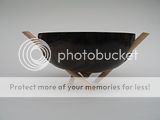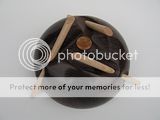You are using an out of date browser. It may not display this or other websites correctly.
You should upgrade or use an alternative browser.
You should upgrade or use an alternative browser.
A bowl in Indian rosewood
- Thread starter Harlequin
- Start date

Help Support UKworkshop.co.uk:
This site may earn a commission from merchant affiliate
links, including eBay, Amazon, and others.
boysie39
Established Member
WoW Harlequin ,you sure put a lot of thought into your work ,this combination of timbers IMO work perfectly on this bowl very well turned and finished I like it . =D>
I had a great browse through your other work and found it to be stunning work , you really put some great effort into what you do .You have a great variety of pieces covering a wide selection of turnings .
What I cant understand is why they gave the Nova lathe that can do this work to you and not me . :evil: :mrgreen:
I had a great browse through your other work and found it to be stunning work , you really put some great effort into what you do .You have a great variety of pieces covering a wide selection of turnings .
What I cant understand is why they gave the Nova lathe that can do this work to you and not me . :evil: :mrgreen:
Silverbirch
Established Member
Your bowl looks very nicely turned and finished. I like the unusual design and as Eugene mentioned, the combination of timbers work well together. It`s hard to do something different with a bowl, without venturing into colouring and texturing etc, so full marks for originality! I`m not sure of the bit that protrudes from the centre underneath, though. It doesn`t seem to add anything to the overall design to my eyes.
Ian
Ian
Thanks Boysie - nice lathe , copes with anything I can throw at it,conversion to variable speed was the best thing I did
Silverbirch - I did try it without the burr but due to the cutouts for the maple rods the bowl appeared a bit eccentric at certain angles so the burr piece was intended to offer a point of focus , there was very little in it though
Alli - thanks, they are indeed horn speakers - a labour of love
Silverbirch - I did try it without the burr but due to the cutouts for the maple rods the bowl appeared a bit eccentric at certain angles so the burr piece was intended to offer a point of focus , there was very little in it though
Alli - thanks, they are indeed horn speakers - a labour of love
tomthumbtom8
Established Member
WoW Harlequin I love your refreshing approach to wood and turning along with balance and form
question
on your speakers you have steam bent some ply how did you go about this
Tom
question
on your speakers you have steam bent some ply how did you go about this
Tom

£16.99
£19.99
Respirator Mask,Safety Dust Face Cover,Dust Face Cover Paint Face Cover,Gas Mask With Filter,For Paint,Dust And Formaldehyde,Sanding,Polishing,Spraying And Other Work
ShenZHEN CIRY MINGYANG LITIAN ELECTRONIC ECOMMERCE

£10.10
£15.48
Portwest Browguard with Clear Visor, Size: One Size, Colour: Clear, PW91CLR
Amazon.co.uk

£199.00
£360.17
Trend Portable Benchtop Router Table with Robust Construction for Workshop & Site Use, 240V, CRT/MK3
Amazon.co.uk

£34.99 (£3.50 / count)
£39.99 (£4.00 / count)
VonHaus Chisel Set - 10pcs Woodworking Tools Set - Wood Carving Tools, Wood Chisel Sets with Sharpening Stone, Honing Guide and Storage Case
VonHaus UK

£10.19 (£0.39 / count)
£11.99 (£0.46 / count)
Nicpro Carpenter Pencil with Sharpener, Mechanical Carpenter Pencils Set with 26 Refills, Case, Deep Hole Marker Construction Pencils Heavy Duty Woodworking Pencils for Architect (Black, Red)
NicproShop EU

£15.99 (£1.60 / count)
£27.44 (£2.74 / count)
3M 8822 Disposable-fine dust mask FFP2 (10-pack)
Amazon.co.uk

£9.99 (£1.00 / count)
£14.45 (£1.44 / count)
JSP M632 FFP3moulded Disposable Dustmask (Box of 10) One Size suitable for Construction, DIY, Industrial, Sanding, dust protection 99 Percent particle filtration Conforms and Complies to EN 149
Amazon.co.uk

£24.99
Facemoon Reusable Masks,Safety Masks,Dual Filter Masks, Paint, Dust, Epoxy Resin, Construction, Welding, Sanding, Woodworking, Chemical Reusable Gas Masks
ShenZHEN CIRY MINGYANG LITIAN ELECTRONIC ECOMMERCE
tomthumbtom8":jqw1dats said:WoW Harlequin I love your refreshing approach to wood and turning along with balance and form
question
on your speakers you have steam bent some ply how did you go about this
Tom
Hi Tom
Steam bending ply is not difficult, getting it just right and consistent is, as different pieces of wood behave differently based on the type of grain orientation
A steamer box and steam from a kettle is adequate (youtube will show various ways to do this and they all work)- let the wood steam for about 15 - 20 mins and then wrap it around a form that you would need to make to size , and hold in place while it dries with elastic bands etc(I used broad strips of tubing so as to not mark the wood)
things to remember - when you bend wood it will spring back a bit - usually about 25%(for 4mm ply) but depends on the thickness, if using thicker ply like 18mm bending it will require a lot of pressure which the average wood shop cannot achieve so simply make some kerf cuts to reduce the bendy element to a smaller thickness(once bent and installed the kerf voids can be dealt with by filling or glue )
The process cannot be speeded up so patience is key
If you get it right first time - it would be luck ,so prepare for errors and mis behaviour of wood - make several pieces and choose the best if you want some consistency in shape
Hope this helps
Similar threads
- Replies
- 4
- Views
- 796



























